
The Master of the Flemish Boethius was a miniaturist active in Flanders in the last quarter of the 15th century.

The Master of the Flemish Boethius was a miniaturist active in Flanders in the last quarter of the 15th century.
The earliest miniatures attributed to the Master of the Flemish Boethius are found in a religious text written for Guillaume de Ternay and currently in the collections of Biblioteka Książąt Czartoryskich in Kraków, Poland. It was written in 1478. The notname Master of the Flemish Boethius is derived from a luxuriously illustrated copy of Boethius in Latin and Flemish, made for Louis de Gruuthuse; it was possibly his last commission, made in 1492. The Master of the Flemish Boethius also contributed to several other illuminated manuscripts commissioned by Louis de Gruuthuse, and also to books commissioned by Edward IV of England and Philip of Cleves. The Master of the Flemish Boethius collaborated with several artists at different times in both Ghent and Bruges. [1]
Stylistically, the Master of the Flemish Boethius is close to the so-called Master of the First Prayer Book of Maximilian, and was at one point misidentified with Alexander Bening, the father of Simon Bening. In the Boethius manuscript, the figrues of women by the Master of the Flemish Boethius have been described as elongated with faces "that resemble wood carvings"; the men are portrayed as stockier and with more individual traits. [1]
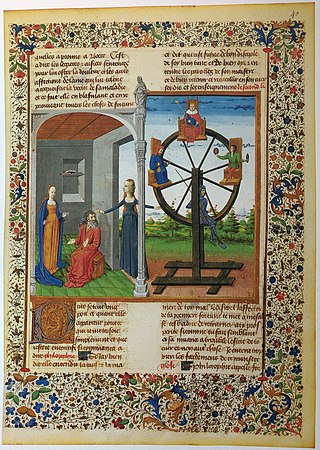
On the Consolation of Philosophy, often titled as The Consolation of Philosophy or simply the Consolation, is a philosophical work by the Roman philosopher Boethius. Written in 523 while he was imprisoned and awaiting execution by the Ostrogothic King Theodoric, it is often described as the last great Western work of the Classical Period. Boethius' Consolation heavily influenced the philosophy of late antiquity, as well as Medieval and early Renaissance Christianity.
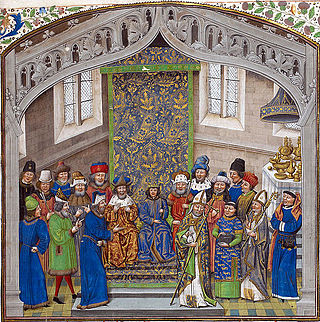
Jean de Waurin or Wavrin was a medieval French chronicler and compiler, also a soldier and politician. He belonged to a noble family of Artois, and witnessed the Battle of Agincourt from the French side, but later fought on the Anglo-Burgundian side in the later stages of the Hundred Years' War. As a historian, he put together the first chronicle intended as a complete history of England, very extensive but largely undigested and uncritical. Written in French, in its second version it extends from 688 to 1471, though the added later period covering the Wars of the Roses shows a strong bias towards Burgundy's Yorkist allies. Strictly his subject is Great Britain, but essentially only England is covered, with a good deal on French and Burgundian events as well.
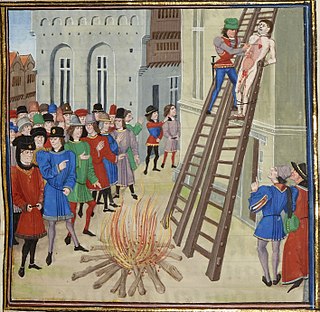
Froissart's Chronicles are a prose history of the Hundred Years' War written in the 14th century by Jean Froissart. The Chronicles open with the events leading up to the deposition of Edward II in 1327, and cover the period up to 1400, recounting events in western Europe, mainly in England, France, Scotland, the Low Countries and the Iberian Peninsula, although at times also mentioning other countries and regions such as Italy, Germany, Ireland, the Balkans, Cyprus, Turkey and North Africa.

The Froissart of Louis of Gruuthuse is a heavily illustrated deluxe illuminated manuscript in four volumes, containing a French text of Froissart's Chronicles, written and illuminated in the first half of the 1470s in Bruges, Flanders, in modern Belgium. The text of Froissart's Chronicles is preserved in more than 150 manuscript copies. This is one of the most lavishly illuminated examples, commissioned by Louis of Gruuthuse, a Flemish nobleman and bibliophile. Several leading Flemish illuminators worked on the miniatures.

Louis de Bruges, Lord of Gruuthuse, Prince of Steenhuijs, Earl of Winchester, was a Flemish courtier, bibliophile, soldier and nobleman. He was awarded the title of Earl of Winchester by King Edward IV of England in 1472, and was Stadtholder of Holland and Zeeland 1462–77.
Jácome de Bruges, 1st Captain-Donee of Terceira was the brother of Louis de Gruuthuse, 1st Earl of Winchester of the wealthy Gruuthuse noble family from Bruges, their grandfather Jean III d'Aa of Gruuthuse participated in the great tournament of Bruges on 11 March, 1393. Jácome became a servant of Prince Henry the Navigator of Portugal, who initiated the so-called Portuguese Age of Discovery in the 15th century.

The Gruuthuse manuscript is a medieval compilation, the oldest core of which is dated about 1395, while the youngest unfinished contributions date from around 1408. The manuscript is the only known source for a large number of Middle Dutch texts.
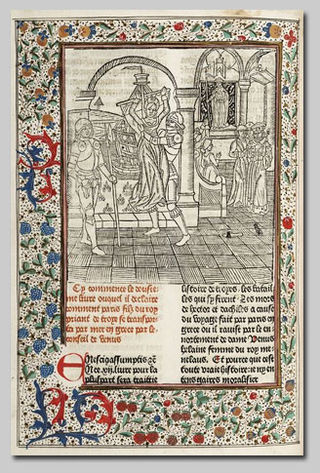
Colard Mansion was a 15th-century Flemish scribe and printer who worked together with William Caxton. He is known as the first printer of a book with copper engravings, and as the printer of the first books in English and French.
Aarsele is a village in the Belgian province of West Flanders and a subdivision of the city of Tielt.

The Master of Anthony of Burgundy was a Flemish miniature painter active in Bruges between about 1460 and 1490, apparently running a large workshop, and producing some of the most sophisticated work of the final flowering of Flemish illumination. He was first identified by Winkler in 1921; his name is derived from one of his most elevated patrons, Anthony of Burgundy, Philip the Good's illegitimate son, though he also worked for the Dukes and other bibliophiles in Burgundian court circles, who had already been allocated "Masters" by art historians. His contributions to the heavily illustrated Froissart of Louis of Gruuthuse from the early 1470s, on which several of the leading illuminators of the day worked, show him excelling some more famous names, like Loiset Lyédet. The young Master of the Dresden Prayerbook worked as his assistant on this book, suggesting he was an apprentice; a number of other anonymous masters have been postulated as his pupils. Other works are in the libraries of Paris, Wrocław, Philadelphia, Munich, Cambridge University Library and elsewhere.

The Hours of Philip the Bold is a late 14th-century illuminated book of hours produced in Paris for Philip the Bold, Duke of Burgundy (1363-1404). It contains illustrated calendars, figured initials and 11 large miniatures with ivy borders, following the Paris liturgy. The manuscript has a devotional use. Philip reportedly recited his daily prayers from this manuscript. His hours, which contains almost 200 images, is one of the most worldly manuscripts to survive from the library of the Burgundian Dukes. It is now MS. 3-1954 in the Fitzwilliam Museum, Cambridge.
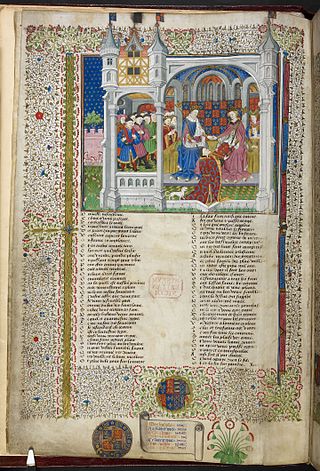
The Royal manuscripts are one of the "closed collections" of the British Library, consisting of some 2,000 manuscripts collected by the sovereigns of England in the "Old Royal Library" and given to the British Museum by George II in 1757. They are still catalogued with call numbers using the prefix "Royal" in the style "Royal MS 2. B. V". As a collection, the Royal manuscripts date back to Edward IV, though many earlier manuscripts were added to the collection before it was donated. Though the collection was therefore formed entirely after the invention of printing, luxury illuminated manuscripts continued to be commissioned by royalty in England as elsewhere until well into the 16th century. The collection was expanded under Henry VIII by confiscations in the Dissolution of the Monasteries and after the falls of Henry's ministers Cardinal Wolsey and Thomas Cromwell. Many older manuscripts were presented to monarchs as gifts; perhaps the most important manuscript in the collection, the Codex Alexandrinus, was presented to Charles I in recognition of the diplomatic efforts of his father James I to help the Eastern Orthodox churches under the rule of the Ottoman Empire. The date and means of entry into the collection can only be guessed at in many if not most cases. Now the collection is closed in the sense that no new items have been added to it since it was donated to the nation.

The Ghent-Bruges school is a distinctive style of manuscript illumination which was prevalent in the Southern Netherlands from about 1475 to about 1550. Though the name highlights the importance of Ghent and Bruges as centres for manuscript production, manuscripts in the style were produced in a wider area.

The Gruuthusemuseum is a museum of applied arts in Bruges, located in the medieval Gruuthuse, the house of Louis de Gruuthuse. The collection ranges from the 15th to the 19th century.

The lords of Gruuthuse were one of the noble families of Bruges in the medieval period. It was one of several families bearing the title of "lords of Bruges" Their heraldic motto was Plus est en vous – Meer is in u.

Jean III d'Aa, lord of Gruuthuse was a Flemish-Burgundian knight of the Bruges noble family of Gruuthuse. He is notable for having fought a great tournament in Bruges on 11 March 1393 against his cousin, Jean (Wulfart) de Ghistelle, lord of Gistel and Harnes. Jean was also the grandfather of Louis de Gruuthuse, himself a "bulwark of Burgundian chivalry" and a notable participant in tournaments in the 1440s.

A presentation miniature or dedication miniature is a miniature painting often found in illuminated manuscripts, in which the patron or donor is presented with a book, normally to be interpreted as the book containing the miniature itself. The miniature is thus symbolic, and presumably represents an event in the future. Usually it is found at the start of the volume, as a frontispiece before the main text, but may also be placed at the end, as in the Vivian Bible, or at the start of a particular text in a collection.
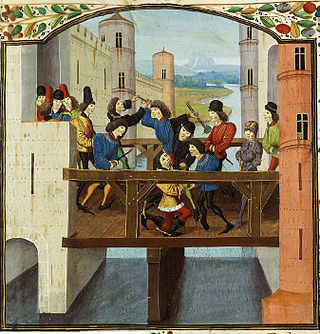
The Master of the Vienna Chroniques d'Angleterre is the name conventionally given to a manuscript illuminator active in Bruges between 1470 and 1480. He owes his name to his work on several manuscripts, including one held by the Austrian National Library in Vienna, of Jean de Wavrin's Recueil des croniques d'Angleterre. He specialised in illuminating manuscripts on historical subjects.

The Master of Margaret of York is the Notname of an illuminator active in Bruges between 1470 and 1480. He owes his name to a devotional book he decorated for Margaret of York, wife of Charles the Bold, Duke of Burgundy. A large number of his illuminated books were executed for Louis de Gruuthuse. Several manuscripts have also been attributed to his assistants.

The Master of the Jardin de vertueuse consolation is the Notname of an illuminator active in Bruges in the years 1450 to 1475. He owes his name to a work by Pierre d'Ailly of which the decoration has been attributed to him, Le Jardin de vertueuse consolation, executed for Louis de Gruuthuse and today preserved in the Bibliothèque nationale de France as ms. fr. 1026.